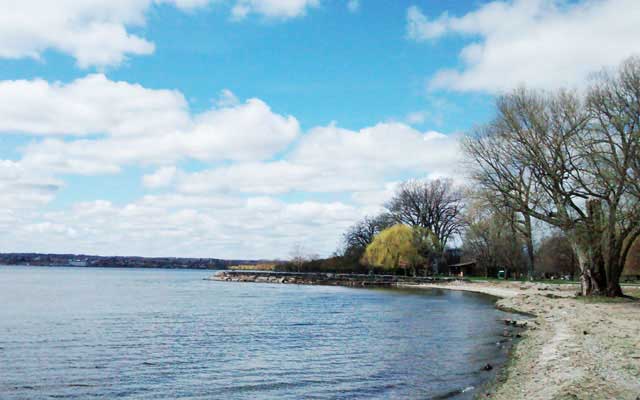FINGER LAKES HISTORY
THE FORMING OF THE LAKES
Two million years ago, the first of a series of glacial flows began seasonally advancing and retreating across what is now New York State. These massive bodies of ice flowed south, carving deep trenches in the earth, grinding across valleys, and gouging the land. They left long, narrow, high-walled lakes and deep gorges in their wake. The geological term finger lake refers to a long, narrow lake in an over deepened glacial valley. Cayuga and Seneca Lakes are among the deepest in the whole of the United States, measuring 435 feet and 618 feet respectively at their deepest points. This means both lakes boast bottoms well below sea level.
EARLY SETTLERS
The Finger Lakes region does, in fact, contain evidence of pre-Iroquois habitation though there is little information to be found on the topic. The Bluff Point Stoneworks, found at the base of Keuka Lake is one such example. Almost nothing is known about who may have constructed these structures and only ruins are left today. The Native Americans who lived in the Finger Lakes area, however, left behind the first recorded history. They believed the Finger Lakes were the fingerprints of the Great Spirit. It is said that the Great Spirit reached down and, in touching the earth, transformed this land into sacred ground. These Native Americans lived in the Finger Lakes for thousands of years before European Settlers ever reached the continent.
The confederacy of Iroquois tribes called their union the “extended lodge” and the Finger Lakes region was the center of their territory. The groups of Cayuga, Mohawk, Oneida, Onondaga, Seneca, and other smaller tribes, enjoyed a kinship that shared the fruits of the land without exercising dominion over it. The two largest of the Finger Lakes, Seneca and Cayuga, were named for their corresponding tribes. The Onondaga and Oneida tribes lived at the eastern edge of the region, closer to their namesake lakes while the easternmost Iroquois tribe was the Mohawk. The Tuscarora tribe could also be found in the Finger Lakes region and eventually became the sixth nation in the Iroquois confederacy. European settlers, when they arrived, solely knew these people as the Iroquois, or the Five (and later Six) Nations.
As one of the most powerful Indian nations during colonial times, the Iroquois were able to prevent European colonization of the Finger Lakes region for nearly two centuries after first contact, often playing the French off against the British interests in savvy demonstrations of political competence. The renowned ingenuity and adaptability of the Iroquois people were key tools of resistance against hostile European powers rapidly spreading throughout North America, eager to dominate and increasingly brutal toward native Americans in the Finger Lakes and beyond. By the late 18th century with the French governmental influence gone from Canada Iroquois power had weakened, relative to the steady growth in European-Americans’ populations, and internal strife eroded the political unity of the Iroquois Confederacy as they faced pressures from colonists itching to move west and a desire to keep them out of Amerindian lands.
When the New World erupted in revolution, most of the Iroquois tribes sided with the British, though some Iroquois sided with the Americans. This had tragic repercussions for the Iroquois as it resulted in a civil war of their own leaving them vulnerable. In the late 1770s, British-allied Iroquois attacked various American frontier settlements. Repercussions were severe in the form of the Sullivan Expedition in 1779 which destroyed most tribal land. In their weakened state, the Iroquois were driven from the Finger Lakes by attacks from the Continental Army.
After the Revolutionary War, most of the Iroquois land including the Finger Lakes region, was opened up to purchase and many veterans were awarded land grants in a two million acre tract of land where they began farming the area. As for the Iroquois and other Indians of the region, they were assigned reservations. Though a great tragedy had befallen the Iroqouis, many Finger Lakes towns, villages, and the lakes themselves bear names derived from Native American languages in remembrance.
A hallmark of the 1800s in the Fingerlakes region was the Seneca Falls Woman’s Rights Convention. Specifically, in 1848, a gathering was held to demand equal social, civil, and religious rights for women across America. Though they were capable of very little in the way of publicity, the turnout was overwhelming with the final numbers being over 300 people in attendance. During the convention, their grievances were discussed and compiled into the Declaration of Sentiments. Based on the Declaration of Independence, this document called for change in order to have a better life. This declaration is most well known for paving the way towards the right to vote. Starting with 11 resolutions, each passed unanimously except #9 the right to vote. It did pass in the end, though barely. The whole historic event is commemorated with both a memorial and museum to learn about the years of work to get to where we are and how much further we have to go.
In the early 1900s, salt mining became a booming industry. 1915 marked the first salt mine on Cayuga Lake; owned by John Clute who founded the Rock Salt Corporation in Lansing. At -1500 ft, the mine was not producing a quality product by the end of the first year of production; this continued til 1918 when it was sold. Under new management, the mine was sunk even further where they were able to find a superior vein of salt. At this time, the company brought an influx of jobs and industry to the area. This particular mine on the side of Cayuga Lake was managed and run by Cayuga Rock Salt until 1970 when it was bought by Cargill who manages it to this day.
LEARN MORE
Vintage Finger Lakes Books:

